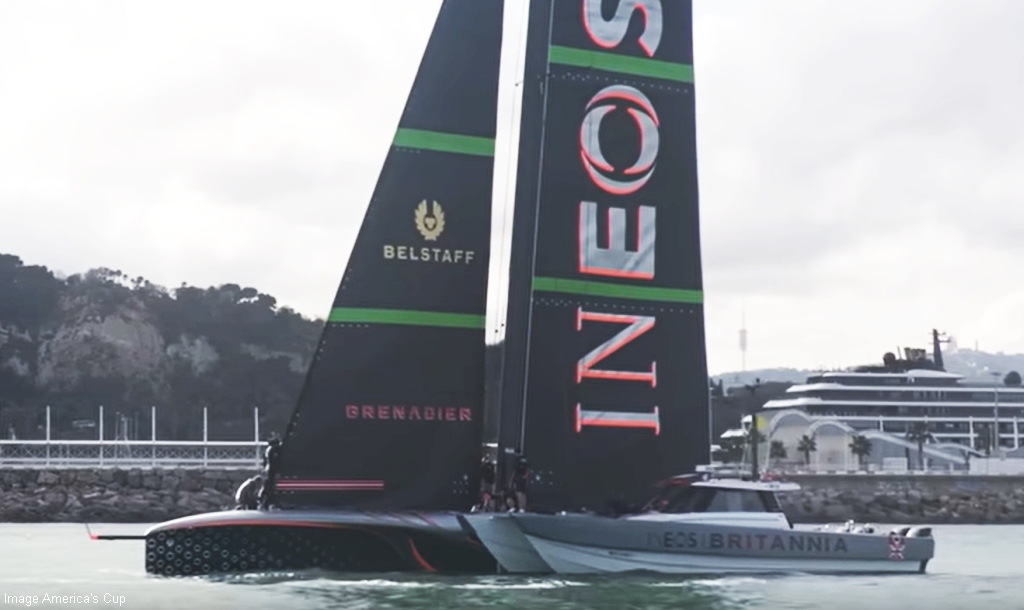INEOS Britannia launched their new AC75 – RB3 – for the first time and started initial tow-testing and sail-fitting procedure in Barcelona.
In the water by 10.15am with the mast up and a swarm of technicians and sailors working diligently through the systems checks, INEOS Britannia was a hive of delighted activity throughout the morning, with a sense of anticipation that could almost be bottled.
For the first time we saw both the foils and stepped-rudder arrangement and with so much speculation shoreside on what innovations this highly technical team, supported by the brilliance of Mercedes Applied Science, have brought through, the recon camera lenses were clicking.
The rudder itself is a departure from the norm, with its foward hull position, and featured two steps leading to a slender bottom section. Mounted aft at the very tip of the trailing edge of the rudder, is a slightly inverted gullwing elevator.
Considerale angular rake adjustments seems to be available. On the tow test, it was noticeable just how forward the rudder angle was raked.
The considerable gap between the rudder and the abrupt end of the deep skeg, is a major design difference of RB3 compared with what we have seen on the other AC75s revealed to date.

The foils were a progressive, logical design, back-slung off a beautifully sculpted bulb and similar in form to Alinghi Red Bull Racing.
The detailing is where the percentages are found, and flow tails were dotted all over the span with the obligatory camera mounted to capture every piece of flow data imaginable and Pitot tubes protruding forward – measurement is everything.

Another highly notable and potentially significant nuance of INEOS Britannia was the crew set-up with the helms sitting in the forward pods and the trimmers sitting right at the back of the boat in the aft pods.
The two-man cyclor team either side were seated in the middle two pods and in the aft cyclor pod HMI (Human Machine Interface) systems could be seen.
INEOS Britannia appears to have gone rather radical here and concentrated weight forward, against the accepted layout where most teams run the trimmer in the most forward position, and this changem is allied with the considerable volume of the bow bustle and the rearward location of the foils.
All these configuration changes effect the relationship between the rudder, foils and sails, and indicate a completely new design thinking.
We will have to wait and see whether this was a commissioning set-up and whether it stays but INEOS Britannia are certainly not afraid to buck convention.

With the yacht in the water, it was very quickly all business. On deck we got a first glimpse of the mainsheet system that the recon team recorded as being: “black outer tube with sheave and yoke at the end removed from interior actuator. Multiple ropes threaded into tube, before connecting back to main actuator.”
The team docked out at 15:25, with tow testing beginning at 15:50 from the port entrance. The yacht was towed 3NM north-east along the coast, before towing 3.5NM south, at speeds between 18-24 knots.
Once on foil, the rudder was noticeably raked forward, pitching the boat down to align the skeg in parallel with the sea level. Tow testing ended at 16:15, with deck hatches opened and crew below deck, as the yacht was slowly towed in displacement back to port.

The M1-1 mainsail was prepared and slowly raised over a 50-minute period.
As techs got to work on the mainsheet and Cunningham systems, the J2-1 was hoisted for 15 minutes, followed by the J3-1 and J1-1. Fairing covers were added over the tack and clew of the mainsail, covering the control systems.
Sails were dropped by 19:40, with the team heading back to base to dock in at 20:00. After sails were carried off the yacht it was subsequently craned out in the dark at 21:30 to conclude a long day of work for the team.
Giles Scott, speaking at the end of the day, expected RB3 to be in the Shed for the weekend and possibly also Monday, due to the expected sea state, but after that they would hope for a first sail.
Related Post . . .
Tom Morris looks at the left field brutalist style INEOS AC75







